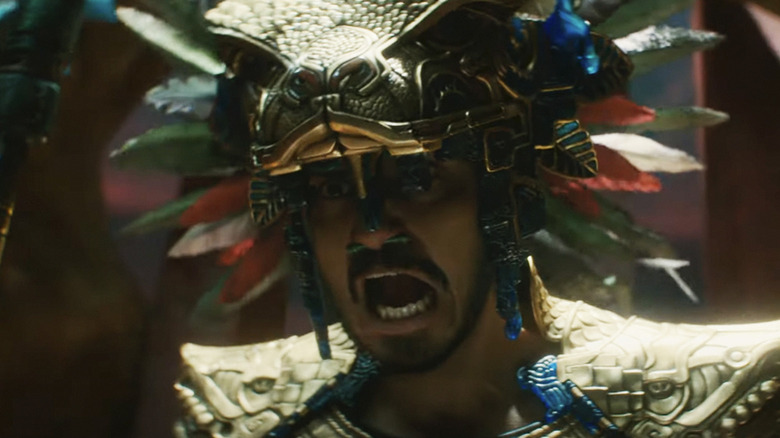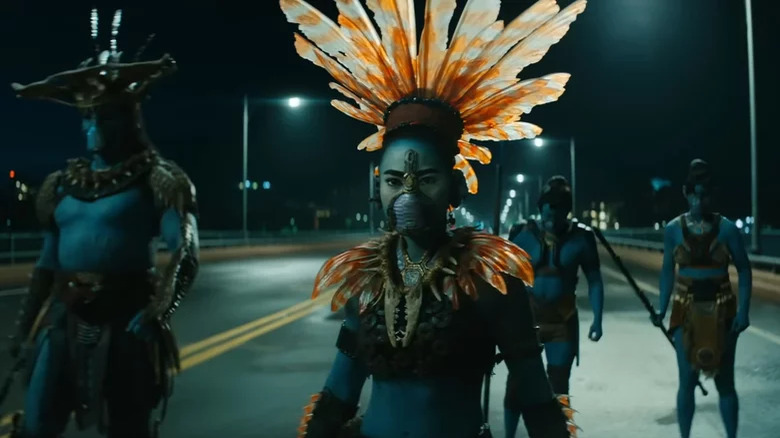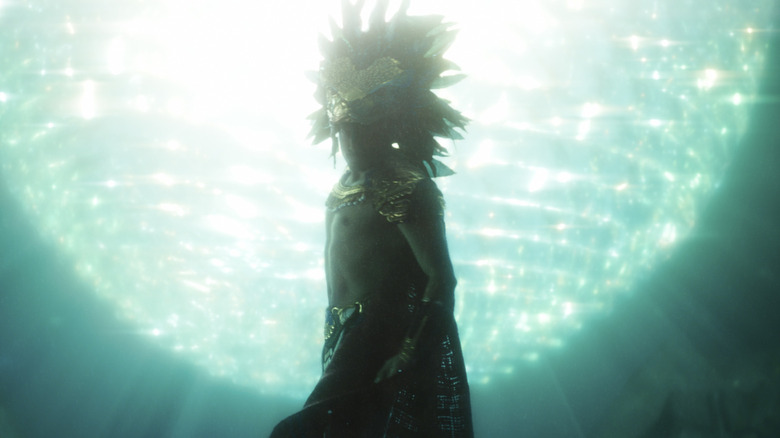Did You Notice The Underwater Corn In Black Panther: Wakanda Forever?
The first "Black Panther" was a jolt of fresh energy to the Marvel Cinematic Universe. It was not just a hugely entertaining film (and one with a fantastic soundtrack), but one that crafted a fictional world that felt real and lived-in, a world you could lose yourself in. Every piece of Wakanda we saw made sense and war imbued with a sense of history and culture so rich in detail you could imagine the countless stories that happened just off-screen. In just one movie, Wakanda became arguably the most real location in the MCU other than New York.
Now, "Black Panther: Wakanda Forever" has done it again. It's a film that offers a poignant exploration of grief; a film with some nuanced commentary on the impact of colonialism; a movie that introduces one of Marvel's oldest characters and reinvents him by rooting him in real history; and also a movie that gives us another beautifully realized and detail-rich location in Talokan. Like Wakanda, Talokan feels very much like a real place, with a sense of history and culture to every nook and cranny.
While "Wakanda Forever" only spends a short amount of screen time in Talokan, we'll likely see more of the sunken empire at some point in the future. Until then, everyone can obsess over the details they missed in the film — like the underwater corn in Namor's backyard.
Yes, underwater corn
Speaking to our own Ben Pearson, Chris White, Weta's VFX supervisor on "Black Panther: Wakanda Forever," talked about adding a lot of corn in the environment around Talokan. Not metaphorical corn, but literal corn:
"There was this whole discussion that [Namor] created this artificial sun and the sun illuminates and that they're growing corn underwater. So as [Namor and Shuri are] traveling through [Talokan], they leave, they go to this architectural area, and as the sun is rising, if you look behind [Namor], there's stalks of this corn. We looked at what was the actual type of corn, there's these translucent husks that are underwater, all these things that it goes by [in a second]. But there was probably a good several weeks of discussing how this corn is built and how it's different."
Sadly, the backstory for the corn didn't make the movie's final cut, but the fact the corn itself was thought of as an important element of Talokan is significant. It shows how much homework went into making it a place rooted in the real world. Corn, you see, is hugely important in Mesoamerican history. The crop was first domesticated in what is now Mexico thousands of years ago. For the Mayans in particular (which inspired Talokan), corn was an important part of their mythology, even thought of as the main element from which humans were made by the gods.
Corn is quite important, actually
As Chris White explained to us, the idea of adding corn to Talokan was to pay homage to a real part of history. "That was part of going back to the Mayan, Three Sisters, corn, like there's a whole gardening story there."
The Three Sisters is the name given to the main agricultural crops of Mesoamerica: squash, corn, and common beans. In a technique now known as "companion planting," corn and beans would be planted together in mounds, with squash in between. Each crop would help the other grow, as the cornstalk would become a sort of trellis for the beans, while the leaves of the squash plant keep the soil below moist.
That "Black Panther: Wakanda Forever" would incorporate The Three Sisters into the design of Talokan is significant because it adds to the idea of Talokan being rooted in real Mayan culture and history. Since the first generation of Talokanis were Mayan people who escaped the Spanish Conquest, they found a way to take parts of their culture and recreate them underwater, like the pyramids. It's little surprise, then, that they somehow also figured out a way to grow corn underwater.
As the MCU moves to bring in a more diverse array of superheroes and explore real-life history and tragedy through a superhero lens (whether it's the Spanish Conquest or the Partition of India), including small but significant details like corn in Talokan is what makes a difference. You may not even notice it on a first viewing, but it's the kind of detail that makes Talokan feel like much more than a cool underwater city in a blockbuster.
"Black Panther: Wakanda Forever" is now playing in theaters.


